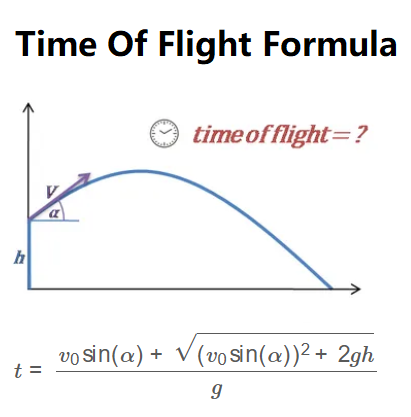1. What is a Time of Flight Calculator?
Definition: This calculator determines the time of flight for a projectile launched at an angle from a certain height, accounting for gravity.
Purpose: It is used in physics to calculate how long a projectile remains in the air, aiding in trajectory planning and analysis.
2. How Does the Calculator Work?
The calculator uses the following formula:
\[
t = \frac{v_0 \sin(\alpha) + \sqrt{(v_0 \sin(\alpha))^2 + 2gh}}{g}
\]
Where:
- \(t\): Time of flight (s, min, hour)
- \(v_0\): Initial velocity (m/s, km/h)
- \(\alpha\): Launch angle (degrees, radians)
- \(h\): Initial height (m, km)
- \(g\): Gravitational acceleration (m/s², g)
Unit Conversions:
- Velocity (v₀): m/s, km/h (1 km/h = 0.277778 m/s)
- Angle (α): degrees, radians (1 degree = π/180 radians)
- Height (h): m, km (1 km = 1000 m)
- Gravity (g): m/s², g (1 g = 9.81 m/s²)
- Time (t): s, min, hour (1 min = 60 s, 1 hour = 3600 s)
Steps:
- Enter the initial velocity (v₀), selecting the unit (m/s, km/h).
- Enter the launch angle (α), selecting the unit (degrees, radians).
- Enter the initial height (h), selecting the unit (m, km).
- Enter the gravitational acceleration (g), selecting the unit (m/s², g).
- Convert all inputs to base units (m/s, radians, m, m/s²).
- Calculate the time of flight using the formula.
- Convert the result to the selected time unit and display.
3. Importance of Time of Flight Calculation
Calculating the time of flight is crucial for:
- Trajectory Planning: Determining how long a projectile will stay in the air.
- Sports: Analyzing the flight of a ball in sports like baseball or golf.
- Engineering: Designing projectiles or launch systems.
4. Using the Calculator
Examples:
- Example 1: For \(v_0 = 20 \, \text{m/s}\), \(\alpha = 45^\circ\), \(h = 10 \, \text{m}\), \(g = 9.81 \, \text{m/s²}\):
- Convert: \(\alpha = \frac{\pi}{4} \, \text{radians}\), \(\sin(\alpha) = \frac{\sqrt{2}}{2}\)
- \(v_0 \sin(\alpha) = 20 \times \frac{\sqrt{2}}{2} = 14.142 \, \text{m/s}\)
- Discriminant: \((v_0 \sin(\alpha))^2 + 2gh = 14.142^2 + 2 \times 9.81 \times 10 = 200 + 196.2 = 396.2\)
- Time: \(t = \frac{14.142 + \sqrt{396.2}}{9.81} = \frac{14.142 + 19.905}{9.81} = 3.472 \, \text{s}\)
- Example 2: For \(v_0 = 36 \, \text{km/h}\), \(\alpha = \frac{\pi}{3} \, \text{radians}\), \(h = 0.1 \, \text{km}\), \(g = 1 \, \text{g}\):
- Convert: \(v_0 = 10 \, \text{m/s}\), \(h = 100 \, \text{m}\), \(g = 9.81 \, \text{m/s²}\)
- \(\sin(\alpha) = \sin(\frac{\pi}{3}) = \frac{\sqrt{3}}{2}\)
- \(v_0 \sin(\alpha) = 10 \times \frac{\sqrt{3}}{2} = 8.66 \, \text{m/s}\)
- Discriminant: \((8.66)^2 + 2 \times 9.81 \times 100 = 75 + 1962 = 2037\)
- Time: \(t = \frac{8.66 + \sqrt{2037}}{9.81} = \frac{8.66 + 45.13}{9.81} = 5.484 \, \text{s}\)
5. Frequently Asked Questions (FAQ)
Q: What if the initial height is zero?
A: The formula still works; the term \(2gh\) becomes zero, simplifying the calculation.
Q: What if the discriminant is negative?
A: A negative discriminant means no real solution exists, likely due to invalid inputs.
Q: Can I use this for vertical launches?
A: Yes, set \(\alpha = 90^\circ\), and the formula will compute the time to reach the ground.
Time of Flight Calculator© - All Rights Reserved 2025
 Home
Home
 Back
Back
